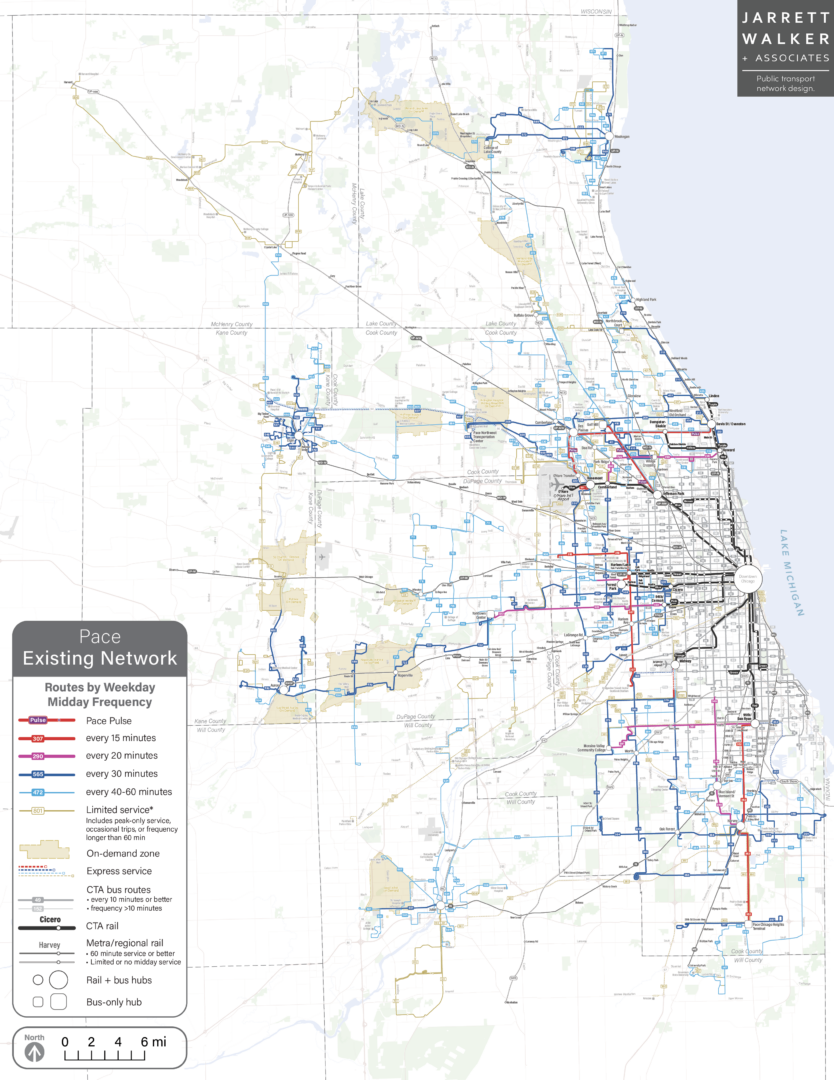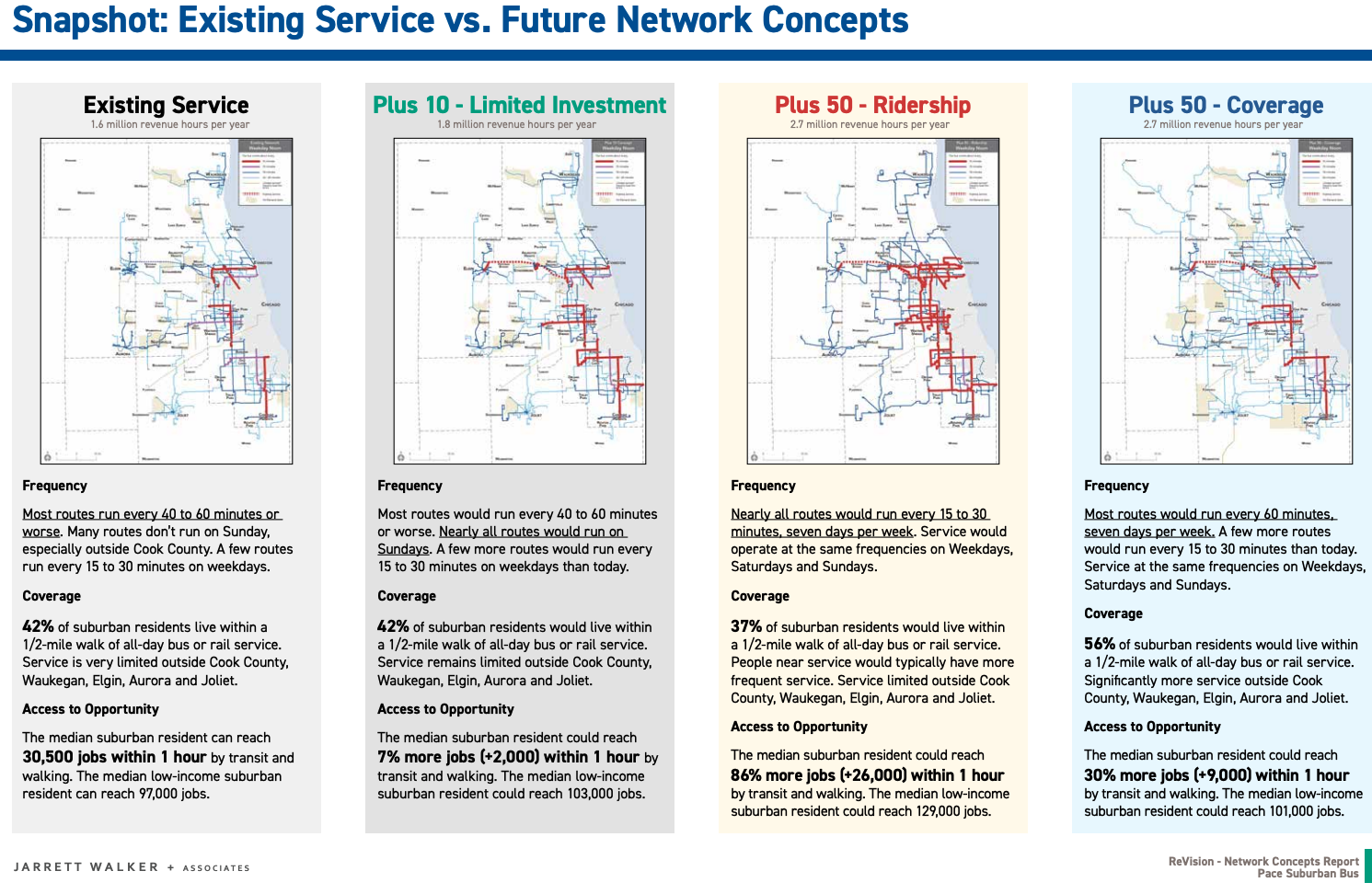One of our firm’s biggest-ever transit planning projects, certainly in terms of land area, is unfolding at Pace, the agency that provides bus service for almost all of the suburbs of Chicago and a few corners of the city itself. Pace is wrapped around all sides of the Chicago Transit Authority network, extending across an area roughly the size of Connecticut. Here’s the current system map for a sense of scale:

The Pace network, with red denoting high frequency. (See legend.) Service is concentrated on the edges of Chicago and in the older satellite cities, leaving large developed areas, including much of DuPage County, unserved.
Right now, network alternatives are out for public review, so we need the input of people who live or work in the Pace service area. If you know such a person, please share this with them, and point them to the project website here.
The Pace ReVision plan is happening in the context of a larger conversation about transit in the greater Chicago region, which I reviewed here. All three of the region’s transit agencies are underfunded, especially as operating costs have risen post-Covid. Pace, in particular, has never been funded to the degree needed to keep up with the vast growth of the Chicago suburbs over the last 70 years. Even now, it’s service is heavily concentrated in the older areas that were built out over 70 years ago, both on the edges of Chicago and in the older satellite cities such as Elgin, Waukegan, Joliet and Aurora. So any meaningful improvement in service needs to presume new resources, and make the case for them.
For that reason, the Pace ReVision project has put three alternatives before the public:
- Plus 10 – Limited Investment. This shows what we could achieve with a return to 2019 service levels, which may be possible within existing funding.
- Plus 50 – Ridership Focus. This shows what the network would look like if we could expand service 50%, to roughly per-capita service level of Connecticut Transit, and if the overriding goal were ridership.
- Plus 50 – Coverage Focus. This shows the same 50% growth but with emphasis on the goal of coverage.
All this is explained in this graphically rich Executive Summary, which I hope you’ll peruse. If you want to go into even more detail, there’s a full report explaining even more of the thinking.
Above all, we need people to engage! This is the moment for people in the Chicago suburbs to think about what they want transit to be. Tell us now for maximum impact!

I’m an alderman for one of the cities served by PACE, and there will be a talk on this subject for Kane County at our public library next week! Very much looking forward to it!
Sadly, I missed the Zoom Open House the other week, but I’ve definitely filled out the survey! I’m pretty excited about all of the proposed options.
When I was in Chicagoland a decade ago, Pace was clearly overperforming given the meager resources it was allocated. I feel your report is very clearly capturing the variety of challenges and geographies that the agency has to operate in.
I have two additional observations. First, Metra provides a regional service with coverage that is unique in North America. There is thus a good case to be made for connecting bus services at low frequency to this network, which would increase the 90 minute coverage map, but not as much the 60 minute one. The is also a glaring gap in the Metra network towards Plainfield that warrants additional Pace resources.
Second, the suburban built environment has badly segregated jobs from residences, with employment largely on highway corridors where nearby residences are located perpendicularly to these corridors. Therefore, routes crossing and connecting this structure, even if the linear density is lower, may outperform those following the linear, but homogeneous, density.
Route 559 is an example of a route that attempts to address the two points above. While it does underperform as compared to routes with strong node, it does overperform, considering the otherwise low density and pedestrian hostile environment in which it operates.
Much of the service area described I explored by bicycle and transit. Only on rare occasions was that transit PACE, as it didn’t really have the regional connectivity that the CTA or Metra could provide.
I think that the plus 50 ridership look is the best in terms of long-term goals and what makes a good transit service. Looking at these services as a public amenity, one must come to the conclusion that more riders means the investment is worth keeping. Cities have to work together in this situation and keeping the collective effort in helping all citizens of Chicagoland get around in what is the most efficient and comfortable for every person.
Thank you for this.